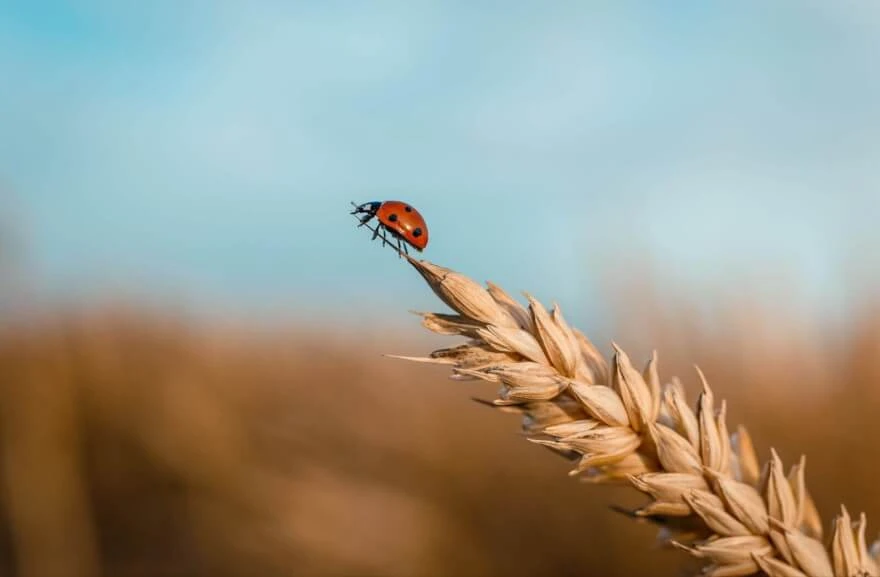Depth of field in photography: the ultimate guide

- Depth of field definition
- Types of DOF and aliases
- What is Short Depth of Field in Photography?
- What is Deep Depth of Field in photography?
- What controls Depth of Field?
- Aperture and Depth of Field
- Focal length and DoF
- Distance relation
- Sensor vs DoF
- How to shoot Shallow Depth of Field?
- How to shoot Deep Depth of Field?
- Example of Depth of Field
- Hyperfocal distance
- Focus stacking method
- Depth of Field calculator
- Conclusion
When we are getting introduced into photography we may become overwhelmed with how many terms and factors are there to consider to have a good shot. There are a lot of settings in our camera, and so many different devices and attachments to apply, and all this is needed just to have a certain control over your shot. With different settings and lenses, we can get shots affected differently. That way each image could achieve a variety of effects. In today’s article, we are going to discuss depth of field photography. We will make a definition for the term and how different settings and devices influence it. Knowing that theory you will be able to get control over your depth of field. To not keep all that in mind we will also suggest an easier way, but having that knowledge will allow you to comprehend the subject better, and then it comes automatically with experience.
Depth of field definition
So, what is Depth of Field? Different sources give different definitions of the term. For instance, Nikon says that Depth of field is determined by the distance from the nearest object plane in focus to that of the farthest plane also simultaneously in focus. The more simple put to this is that depth of field is the part of your photograph from front to back that is in focus. Due to the fact that the camera can only precisely focus the lens at one spot, at one distance at a time, sharpness gradually decreases on each side of the focus distance. Therefore, depth of field is the distance between the nearest and the furthest element in the scene that appears exactly sharp in the photo.
Types of DOF and aliases
Depth of field has 2 stances, shallow and deep. They can be named differently in different communities which may confuse beginners, so let us take a look at their aliases first.
Shallow, narrow, short, small – these are all the same kind.
Deep, long, wide, and deep focus – are also the same kind.
What is Short Depth of Field in Photography?
The shallow depth of field is when we have a small focus area to emphasize the subject when the rest is blurred in the frame.

What is Deep Depth of Field in photography?
Deep focus does the opposite and gives you clean images instead. Before we go to examples and the ways to use it we need to define what makes the difference.

What controls Depth of Field?
To define depth of field in photography we need to understand what factors influence it.
Setting up depth of field you get the creative control of what appears in focus and out of focus. By changing the settings in your camera you can control how deep or shallow this is. So when the depth of focus is deep we get a clear image all over the frame, and when it is shallow, we get only part of our image in focus while the rest is blurred to some extent.
There are 3 main and one co-factor that will allow you to adjust Depth of Field:
- Aperture
- Focal length
- Relative distances to subject and background
- Camera sensor
Aperture and focal length are the features of your lens while the distance to the subject and background is your physical proximity control. Camera sensor also takes its part in DOF control but is usually neglected because can be compensated with other settings. However, it is important to know the sensor influence because most of the time it stays in shadow. This is what controls the depth of field in photography. Let's look at how each aspect on this list will affect Depth of Field and trace the dependencies and interactions between them.
Aperture and Depth of Field

Aperture is the lens feature and also a setting in your camera controls that have the most control over depth of field and is probably the most influential parameter of photography in general. The aperture is the hole in the lens through which light travels into the camera body and onto the camera sensor. To have a better understanding let us look at the human eye. All cameras are designed the same way. The cornea of our eye is similar to the front element of the lens gathering light and bending it inward toward the iris. The iris can expand or shrink controlling the size of the pupil which passes light into the inner eye. The pupil is what we refer to as the aperture in photography. The amount of light that falls onto the retina is determined by the size of the pupil. The larger the pupil the more light falls onto the retina. The larger the aperture of the lens the more light enters the camera. The iris of the lens controls the size of the aperture and is called the diaphragm. Its function is to block all light with the exception of the light that goes through the aperture.

In photography, the aperture is expressed in F numbers also known as F-stops. F-stop's number is the way of describing how open or closed the aperture is. A smaller F-stop means a larger aperture, while a larger F-stop means a smaller aperture. This can be tricky to remember since large f-stops mean small aperture size. So an f-stop of F/1.4 is larger than F/2.8 and much larger than F/8 or F/11. Aside from controlling the amount of light passing through the lens and into the camera, the aperture has a direct impact on the depth of field. In the area of the image that appears sharp, a large F-number such as f/16 will bring all foreground and background objects into focus. While a small F-number such as F/1.4 will isolate either the foreground or background objects and make everything else blurry.
Every lens has a limit on how large or small the aperture can get. If you take a look at the specifications of your lens it should indicate the maximum apertures. Lowest F-numbers and minimum apertures highest def numbers. The maximum aperture of the lens is much more important than the minimum aperture because it shows the speed of the lens. Lenses with apertures of 1.4 or 2.8 are considered fast lenses because they can pass more light into the camera. This is very important for night photography and can also affect depth of field limitations due to low light conditions.
The minimum aperture value is less critical for a certain reason. When we use apertures of more than f/16 diffraction of the light comes into play and causes the image to lose clarity despite the function the aperture value should bring. It is just light physics.
To resume on that and have a more simple put we say that the more open the aperture the more shallow depth of field we get and the opposite. For many people, the aperture is the only thing they are taught about DOF in the early learning stage. However, this is just a part of the puzzle.
Focal length and DoF

Focal length is also a parameter of your lens measured in millimeters. There are two types of lenses: primes and zooms. Prime lenses have a fixed focal length meaning they can not zoom without physically moving closer or further away from the subject. Zoom lenses give you the flexibility for you to zoom in or out of an object while remaining stationary. While prime lenses will have a fixed maximum aperture the maximum aperture of a zoom lens will often get smaller as the focal length increases. These lenses are called variable aperture lenses. This is important because, from a zoom lens with a focal length of 70 to 200 millimeters, the aperture may increase from F/3.5 to F/5.6 decreasing the amount of light entering the camera and thus taking effect on the depth of field.

So now that we knew what focal length definition is, let us make research on how this parameter affects depth of field. For that we need to do 2 shots of the same picture from the same position and the aperture stays the same. Let us say we use 85 mm and 135 mm lenses to shoot the image. When we do that we will notice a difference in background defocus, where an 85 mm lens will make the background sharper compared to a 135 mm lens which makes it relatively blurry. Going further we can establish the aperture relation between these two lenses. 85 mm with an aperture of F/1.8 would be similar to F/5.6 with 135 mm in terms of background focus. So the focal length is a noticeable determining factor when it comes to depth of field.
Distance relation

If you and the background are fixed try moving the subject closer to you and away from that background. If you can not move the subject move closer to the subject to reduce the distance between you and your subject relative to the distance between the subject and the background. The closer your subject is to you relative to the background the more you will move your plane of focus closer to the camera. And the closer that plane of focus is to your camera the shallower it will get. If we use a wide-angle lens then the closer we are to the subject the shallower will be the depth of field and the background blurred. With zoomed lens, we can step back and zoom in instead to get the depth more shallow. With the right distancing from the subject, you can do the exact same framing using different lenses. However, if our focal point stays somewhere on the horizon we will get a sharp shot with no shallow depth. That is why the distance to the subject is essential and the relation distance between the subject and the background.
Sensor vs DoF

We also need to consider sensor size and understand how it affects depth of field. If all other settings are equal, then with a cropped sensor camera we need to use a shorter focal length. In other words, we need to use the same effective focal length. For instance, if we use a 50 mm lens the cropped sensor with a crop factor of 1.5 will get the same framing will require a 35 mm lens. The larger the sensor the larger the depth of field would be considering the same effective focal length. To do these measurements there is the depth of field calculator exist which we will discuss a bit further in this article.
How to shoot Shallow Depth of Field?
As we get the depth of field in photography definition we now can do a quick recap on how to make Shallow Depth of Field. For that, we need:
Open the aperture wider
Get closer to the subject
Focus at a shorter distance
Use Telephoto lens for the longer focal length
Use Full-frame sensor
All these combined will provide you with Shallow Depth of Field and by controlling these settings you can control the amount of bokeh.
How to shoot Deep Depth of Field?
If we want to do the opposite and shoot deep depth of field for landscapes for example then we can do the following:
Close the aperture (consider the diffraction factor)
Get further away from your subject
You can increase your focus distance
Use a shorter focal length
Use cropped sensor
With this in mind, you can get more details in your frame, sharp image, and deep focus which is good for shooting landscapes.
Example of Depth of Field
As we already know there are 2 types of depth of field. Shallow or narrow depth of field is used to make either a nice bokeh and emphasize the subject while the background stays in a blur. Bokeh is an official term for having a blurred background and emphasized subject in the image. This allows you to be creative and get outstanding shots. The variety of usage for this effect is huge. You can make portraits with it, you can blur the lights if you like night and street photography. Bokeh and shallow depth allows you to shift your viewer's focus and pay attention to the details you want. Manipulation is a strong power, and it all comes down to your imagination when you know how to get the effect.

Deep depth of field or deep focus is mostly used for landscape photography, where having everything stay in focus is important. Wide-angle lenses of 14-24 mm have a common use in landscape photography due to their depth of field and framing features. Having a wide-angle lens you can get more in your frame, and it will stay in focus by a huge distance compared to telephoto lenses. Every photographer has at least one of those in their gear.

Hyperfocal distance

When we focus on the background it becomes sharp, but we lose the focus on the foreground instead, and the opposite. The obvious solution that many would think of is to use a smaller aperture, something like f/22 or even smaller. But the solution is not ideal because at some point reaching the sweet spot of your lens, the sharpness will be reduced. And the solution is to focus somewhere in between the foreground and the background at a point where you get the maximum depth of field, this point is known as hyperfocal distance. Think of it like this – you are trying to focus as closely as possible, but the background should be sharp. If you focus closer than this point then the background is not sharp, and you are defeating the purpose. The best practical approach to calculate HFD is to use the double-the-distance method. If you have a foreground subject suppose at a distance of 4 feet from your camera, you focus at 8 feet. That way everything at 4 feet to infinity will be in focus. That is it, it is very simple. Now, the problem is that some of the lenses do not have a focusing scale, or they have it but are not that accurate. What you can do in such situations is walk and calculate the number of steps from the camera to the foreground subject and then walk the same amount of steps further away from the subject this would be your focal point and everything including the foreground and the background will stay sharp. Sometimes, when walking is not possible, let us say you are in the mountains and stay on the edge to shoot some landscape, then you can calculate that using an app. Always double-check the focus even after calculating the distance, because the small LCD of your camera can give you the wrong representation without zooming on the image. Also, make sure that JPEG sharpening setting in your camera is set to zero. Otherwise, you may believe that your image is in a good focus and sharp when in reality this setting just tricks the eye.
Focus stacking method
The hyperfocal method is not perfect and has a lot of dependencies on your aperture, lens, and sensor crop factor. Focus stacking is the method that allows you to stack the focus of your image using different focal points in post-processing in Light Room or Photoshop. You can learn more about focus stacking in this article.
Depth of Field calculator

If you have a hard time keeping all the values and relations in mind, there is a simple way to estimate Depth of Feld in photography. You can basically calculate everything with an app that contains all the relations. The only thing you need to do is to write down the settings you use such as aperture, focal length, crop factor of your sensor, and so on. Then choose your camera from the list presented in the app. Most of the apps allow you to reconsider different focal lengths in case you want to replace the lens and get the same framing which is a valuable feature. You can also calculate values in case you want to get certain framing as if you shoot in full frame sensor but have cropped. For that, you need to know the crop factor of your sensor and write it down in the menu. There is no good advice or recommendation on which calculator to use, just go to App Store or Google Play and write down “DoF calculator”, and you will get the list of apps. They are pretty similar in functionality, the crucial difference is if your camera will be in the list of that calculator application.
Conclusion
Depth of field is probably the most controversial thing discussed in photographers' communities that try to influence and control it. Knowing all the ways that you can manipulate depth of field will make you a more creative photographer. It will allow you to control your environment better. Another benefit of having the knowledge is that will keep you from thinking that you have always got to look for F/1.2 and F/1.4 lenses in order to hit the depth of field you want. So create beautiful imagery and save money on the gear while at the same time knowing how to control that feature.
Co-founder of RetouchMe. In addition to business, he is passionate about travel photography and videography. His photos can be viewed on Instagram (over 1 million followers), and his films can be found on his YouTube channel.
Moreover, his profile is featured on the most popular and authoritative resource in the film industry — IMDb. He has received 51 international awards and 18 nominations at film festivals worldwide.

with RetouchMe














